Franz Peter Schubert
(1797-1828)
An enormously prolific composer despite his tragically short life, Schubert wrote over six hundred songs, nine symphonies, five masses, and numerous piano compositions. Only about twenty-five percent of his compositions had been published at the time of his death, but musicians and audiences nevertheless recognized that Schubert was a remarkable talent. As the poet Franz Grillparzer wrote on the inscription of Schubert’s grave, “The art of music has here entombed a rich treasure but even fairer hopes.”
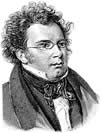 A Prolific Young Composer A Prolific Young Composer
Franz Peter Schubert was born in a one-room Viennese residence on January 31, 1797. His father was a school teacher and headmaster, but also an enthusiastic musician who gave eight-year-old Franz Peter his first violin lessons. Piano lessons began with older brother Ignaz, and the church organist in the Schuberts’ district of Lichtental taught the boy counterpoint, organ, and singing.
At eleven, in 1808, he became a choirboy in the Imperial Hofkapelle (court chapel), thus gaining entry into the prestigious boarding school known as the Kaserlich-königliches Stadtkonvikt (The Imperial-Royal City College). He attended the Stadtkonvikt for five years, playing in the second violin section of its orchestra, and receiving high marks academically. Until he was thirteen, Schubert also studied regularly with the court music director Antonio Salieri, who was then in his fifties.
While it is not clear as to when Schubert began composing, he produced his earliest surviving works between 1810 and 1811, when he was thirteen. These include an ambitious piano duet (Fantasie in G, d1) and the song “Hagars Klage” (d5). His first string quartet (d94), also from 1811, seems to have been inspired by playing in a Schubert family quartet during a holiday from school. Three more quartets followed, along with a symphony (d82) in 1813.
When his voice broke in 1812, Schubert stayed at school for a short time, but soon entered a training program for teachers. He taught at his father’s school sporadically between 1815 and 1818, though he spent much of his time focused on music. While preparing for his teaching career, he returned to Salieri for composition lessons; the older man, famous for his operas, was an appropriate instructor for a young composer with an ardent love for opera. Schubert completed his first opera, Der Teufels Lustschloss (The Devil’s 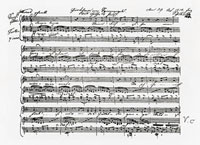 Pleasure-Palace), in 1814. The same year saw the premiere of his first mass, d105, at his school. His acquaintance with Johann Wolfgang von Goethe’s Faust in 1814 led to two of Schubert’s earliest and most famous songs, “Gretchen am Spinnrade” and “Erlkönig.” Schubert’s friend, Johann Mayrhofer, became another significant poetic influence, resulting in notable settings such as “Am See.” Pleasure-Palace), in 1814. The same year saw the premiere of his first mass, d105, at his school. His acquaintance with Johann Wolfgang von Goethe’s Faust in 1814 led to two of Schubert’s earliest and most famous songs, “Gretchen am Spinnrade” and “Erlkönig.” Schubert’s friend, Johann Mayrhofer, became another significant poetic influence, resulting in notable settings such as “Am See.”
In 1815, at the age of eighteen, Schubert, who had already shown great talent in the area of vocal music, produced an astounding one hundred and fifty songs. Thus, by nineteen his cumulative output of solo songs totaled more than three hundred. Poets important to Schubert included Ludwig Heinrich Christoph Hölty, Friedrich von Matthisson, Ossian, and Friedrich Gottlieb Klopstock.
In the same year, he finished two string quartets (d112 and d173), two symphonies (Nos. 2 and 3), two masses (in G and B-flat, respectively), and four Singspiele. One of these, Die Freunde von Salamanka, is set to a libretto by Mayrhofer, and another, Claudine von Villa Bella, to an early work of Goethe. The latter was partially lost in the revolution of 1848. The fact that many of his opera manuscripts were left incomplete, or suffered damage in subsequent years, may be somewhat responsible for the absence of Schubert’s name from the operatic canon. Some of the blame also falls upon the contemporary preference throughout Europe for Italian opera, particularly for the work of Gioacchino Rossini. Schubert’s operas Alfonso und Estrella (1821), to a text by the composer’s friend Franz von Schober, and Fierrabras (1822), commissioned by impresario Domenico Barbaia, were never performed in Schubert’s lifetime.
Schubert’s Early Twenties
In 1816, for a brief time Schubert left his father’s house and his job to stay with Franz von Schober and his family. Schober introduced his friend to the well-known baritone Johann Micahel Vogl, who admired Schubert’s songs and, from that time forward, did his best to promote them. Some of Schubert’s best-loved songs date from 1817, including “Ganymed,” “An die Musik,” and “Die Forelle.”
Did You Know...?
Jonah calls Schubert "the sad one" as a way of differentiating him from Robert Schumann in Woody Allen's Crimes and Misdemeanors ( 1989).
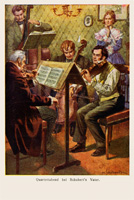 Toward the end of that year, financial considerations prompted a return to his father’s house and to his teaching position. Soon after, the family was transferred to a new school and a new district, and Schubert’s professional duties were demanding. But Schubert was also beginning to gain a public reputation as a composer. His first publication was the song “Erlafsee.” Toward the end of that year, financial considerations prompted a return to his father’s house and to his teaching position. Soon after, the family was transferred to a new school and a new district, and Schubert’s professional duties were demanding. But Schubert was also beginning to gain a public reputation as a composer. His first publication was the song “Erlafsee.”
In 1818, through a friend, he obtained a temporary position tutoring the two daughters of Count Johann Karl Esterházy in Zseliz, Hungary (now Zeliezovce in Slovakia). Surrounded there by amateur musicians, Schubert composed a little for the talents of his hosts, but soon found himself to be the only dependable proponent of his own work. When Schubert returned with the Esterházys to Vienna, he moved in with his friend Mayrhofer.
In the summer of 1819, Schubert traveled through Austria with the singer Vogl, and composed the “Trout Quintet” (d667), based on his song “Die Forelle” (“The Trout”). That same year, “Schäfers Klage” became the first of Schubert’s songs to receive a public performance. Performances of Schubert’s works increased in number throughout 1820, with an overture (thought to be d648) played in Graz, and a singspiel, Die Zwillingsbrüder, performed six times to a mixed reception. The melodrama Die Zauberharfe fared similarly. In a fourth revision, the song “Die Forelle” was at last published, and Schubert also completed a single movement for a string quartet. This fragment is known today as the “Quartettsatz,” and is regarded as a work newly mature in style.
Schubert’s songs were performed often at private soirées among his friends, as the composer accompanied Vogl or other singers at the keyboard, or sang himself. Participants called such evenings “Schubertiades,” a term immortalized in an 1865 drawing by artist and former soirée attendee Moritz von Schwind. In Schwind’s rendering, numerous luminaries of contemporary Vienna can be identified and include well-known literary, musical, and artistic minds, as well as Schubert’s aristocratic student Countess Caroline von Esterházy. These gatherings, which occasionally expanded into more public events with larger audiences, particularly focused on songs, partsongs and keyboard works. His orchestral works did not figure in the intimate Schubertiades, but in 1822, Schubert nonetheless set down the movements now known together as the “Unfinished” Symphony.
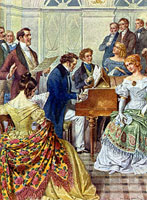 As his numerous compositions were steadily published, he was paid quite satisfactorily. But in the early 1820s he struggled with a brutal work pace, a penchant for drinking, an inability to manage his money, and health concerns which biographers today believe to have been the initial symptoms of syphilis. In spite of his illness, in 1823 and 1824, he composed and published the important song cycle Die Schöne Müllerin, published the “Wanderer” Fantasy (d760), wrote his opera Fierabras (first performed in 1897), and supplied the incidental music to Rosamunde, Fürstin von Zypern, a play by composer Carl Maria von Weber’s former librettist Helmina von Chézy. In 1824, the Schubertiades ended as the circle of friends was disbanded through travel and personal conflicts, and Schubert’s health deteriorated. However, in that year he also produced his Octet (d803), and the Quartet in D minor (d810) called “Death and the Maiden.” As his numerous compositions were steadily published, he was paid quite satisfactorily. But in the early 1820s he struggled with a brutal work pace, a penchant for drinking, an inability to manage his money, and health concerns which biographers today believe to have been the initial symptoms of syphilis. In spite of his illness, in 1823 and 1824, he composed and published the important song cycle Die Schöne Müllerin, published the “Wanderer” Fantasy (d760), wrote his opera Fierabras (first performed in 1897), and supplied the incidental music to Rosamunde, Fürstin von Zypern, a play by composer Carl Maria von Weber’s former librettist Helmina von Chézy. In 1824, the Schubertiades ended as the circle of friends was disbanded through travel and personal conflicts, and Schubert’s health deteriorated. However, in that year he also produced his Octet (d803), and the Quartet in D minor (d810) called “Death and the Maiden.”
His symptoms improved significantly in 1825, and for over a year he was well. He moved to a house near Schwind, and wrote his Piano Sonata in A minor (d845). A second sonata in C major (d840) was left incomplete. Schubert and Vogl took several months to travel again, visiting friends and patrons at whose keyboards the composer worked on the Piano Sonata in D major (d850), and on what would become the symphony called “The ‘Great’ C Major.” His Mass in C Major and several songs were published in 1825 as well.
Die Winterreise; Death at a Young Age
Upon his return to Vienna, Schubert’s now declining health and finances did not improve. He applied for the position of second kapellmeister after the former occupant was called to replace Salieri, who had died, but the job was eliminated. Beethoven, a hero of Schubert’s, died in 1827; he is said to have seen some of Schubert’s works during his final illness, and to have been greatly impressed by them. Schubert served as a torchbearer at Beethoven’s funeral. This death and the young man’s difficult circumstances all contributed to Schubert’s depression during 1827, and neither his return to Schober’s residence, nor the subsequent hosting of Schubertiade performances improved his outlook. That most despondent of song cycles, Die Winterreise, dates from this year. For this work, Schubert returned to the poems of Wilhelm Müller, the author who had previously inspired him to write the groundbreaking Die Schöne Müllerin. If unhappy, 1827 nonetheless proved to be a productive time for Schubert. He also completed two sets of impromptus for piano (d899 and d935), two piano trios (d898 and d929), the Fantasia for Violin and Piano (d934), and a number of songs.
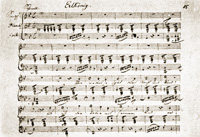 After a Schubertiade with Schober in early 1828—one which proved to be the last such gathering—Schubert presented a public program of his own works, through his association with the prestigious Gesellschaft für Musikfreunde. The concert was well attended and Schubert was handsomely paid. When his illness progressed that summer, the court physician suggested that Schubert go to live with his brother Ferdinand in a suburb of Vienna. There, he turned out several further compositions, including “Der Hirt auf dem Felsen” (The Shepherd on the Rock”), the String Quintet in C major (d956), and an assortment of songs published together, posthumously, as Schwanengesang (Swan Song). After a Schubertiade with Schober in early 1828—one which proved to be the last such gathering—Schubert presented a public program of his own works, through his association with the prestigious Gesellschaft für Musikfreunde. The concert was well attended and Schubert was handsomely paid. When his illness progressed that summer, the court physician suggested that Schubert go to live with his brother Ferdinand in a suburb of Vienna. There, he turned out several further compositions, including “Der Hirt auf dem Felsen” (The Shepherd on the Rock”), the String Quintet in C major (d956), and an assortment of songs published together, posthumously, as Schwanengesang (Swan Song).
By the middle of November, Schubert was seriously ill, eventually to the point of delirium. He died on November 18, 1828 at the age of thirty-one, and was buried, per his deathbed request, near Beethoven. His vast and admirable musical legacy includes over six hundred songs, nine symphonies, five masses, and numerous piano compositions. His work has been especially influential in the area of song, and his more than thirty innovative piano duets did much to revitalize that genre.
References:
Gibbs, Christopher H. The Life of Schubert. Cambridge, UK: Cambridge University Press, 2000.
Winter, Robert, Maurice J.E. Brown, and Eric Sams: 'Schubert, Franz (Peter)', Grove Music Online ed. L. Macy (Accessed 29 September 2005), <http://www.grovemusic.com> |








